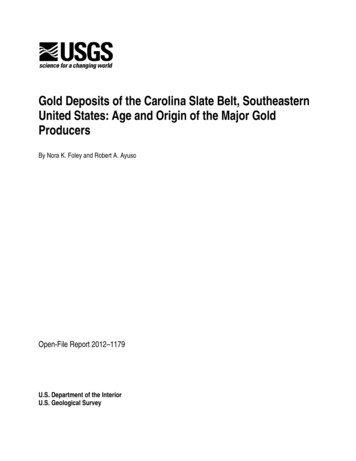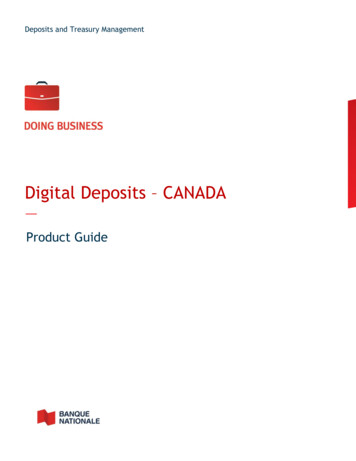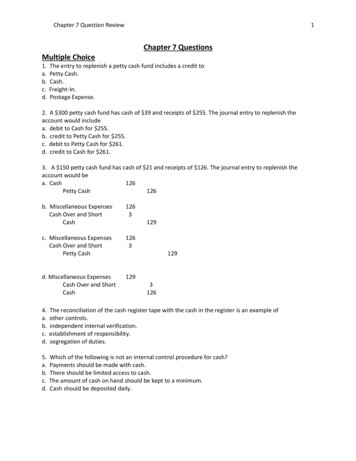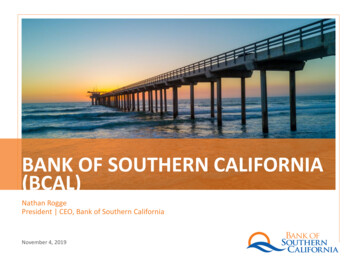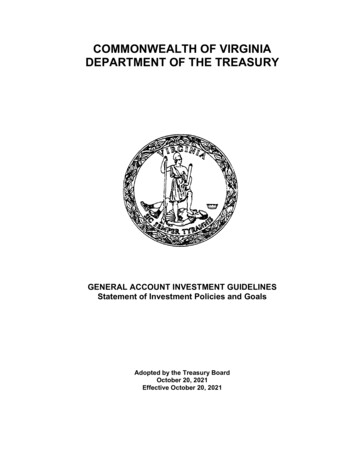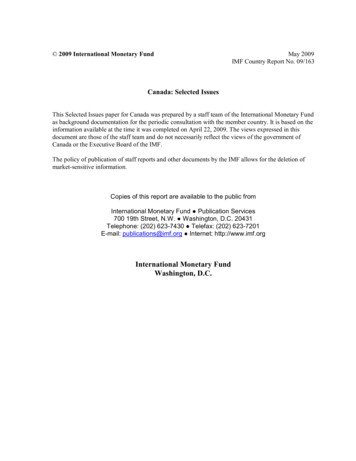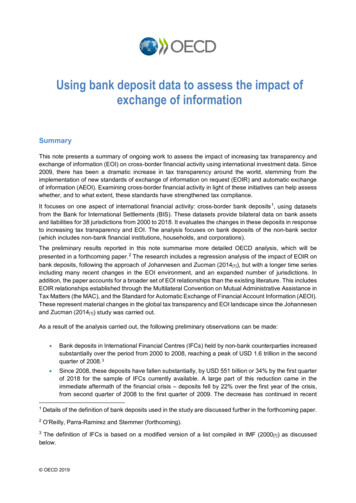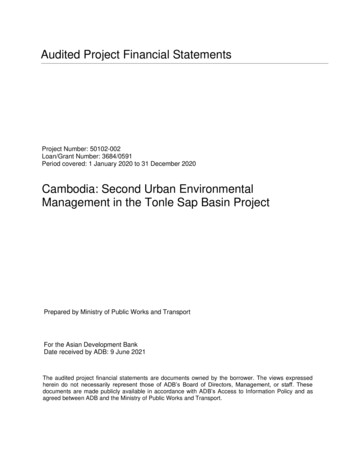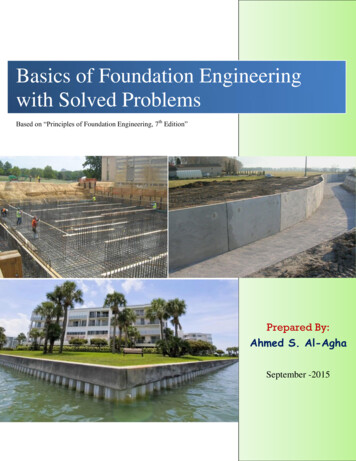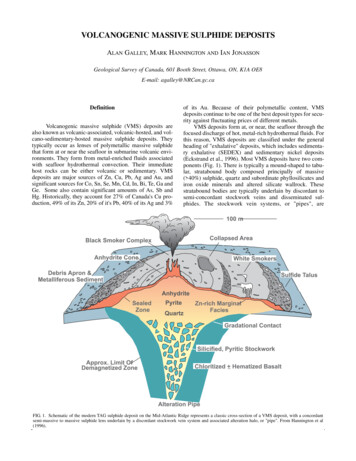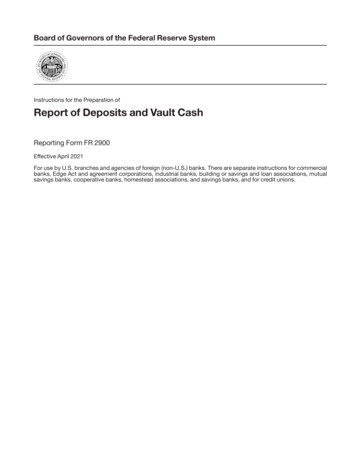
Transcription
Board of Governors of the Federal Reserve SystemInstructions for the Preparation ofReport of Deposits and Vault CashReporting Form FR 2900Effective April 2021For use by U.S. branches and agencies of foreign (non-U.S.) banks. There are separate instructions for commercialbanks, Edge Act and agreement corporations, industrial banks, building or savings and loan associations, mutualsavings banks, cooperative banks, homestead associations, and savings banks, and for credit unions.
ContentsGeneral Instructions. GEN-1B. Where to Report . GEN-1C. How to Report . GEN-2D. Requests for Revised Data . GEN-4E. Liabilities That Are Reservable under Regulation D . GEN-4F. Deposits as Defined under Regulation D . GEN-5G. Treatment of Trust Funds . GEN-7H. Treatment of Escrow Funds . GEN-8I. Treatment of Payment Errors . GEN-8J. Treatment of Sweep Arrangements . GEN-8K. Mergers . GEN-9L. Treatment of Suspense Accounts . GEN-9M. Netting . GEN-9A. Who Must ReportItem InstructionsDemand Deposits Due to the Public(Item A.1). ITEM-1Other liquid deposits (Item A.2) . ITEM-3Cash Items in Process of Collection(Item B.1). ITEM-6Small Time Deposits (Item C.1) . ITEM-7Reporting of Deposits Issued on aDiscount Basis. ITEM-7Reporting of Brokered Time Deposits . ITEM-8Vault Cash (Item D.1) . ITEM-10Annual Items . ITEM-11Reservable Liabilities (Item E.1) . ITEM-11Net Transaction Accounts (Item E.1.a) . ITEM-11Worksheet for Preparing Annual Items . ITEM-12Worksheet Line 4:Total Transaction Accounts (Sum of lines 1, 2, and 3)FR 2900. ITEM-12CONTENTS-1
ContentsWorksheet Line 5:Balances Due from Depository Institutions in the United StatesWorksheet Line 8:Total Nonpersonal Time Deposits. ITEM-14. ITEM-14Worksheet Line 9:Ineligible Acceptances and Obligations Issued by Affiliates Maturing in Seven Days or More(Nonpersonal Only). ITEM-16Worksheet Line 10:Net Eurocurrency Liabilities. ITEM-18Glossary. GL-1ATS (Automatic transfer service) account . GL-1Bankers’ acceptance . GL-1Bankers’ bank . GL-1Banking business . GL-2Bank note . GL-2Bona fide cash management . GL-2Branches and agencies of foreign (non-U.S.) banks . GL-2Brokered deposits . GL-2Brokers security draft . GL-2Cash collateral account . GL-2Certificates of indebtedness . GL-2Club accounts . GL-2Commodity or bill of lading draft . GL-2Credit balance . GL-3Custodial inventory program . GL-3Dealer reserve or dealer differential account . GL-3Demand deposit . GL-3Deposit notes . GL-3Depository institution . GL-3Deposits . GL-4Draft . GL-4Acknowledgment of advanceCONTENTS-2FR 2900
Contents. GL-4Edge Act and agreement corporations . GL-4Exempt entities . GL-4Exemption amount . GL-5Federal public funds . GL-5Federal Reserve draft . GL-5Finance bills . GL-5Foreign (non-U.S.) bank . GL-5Foreign (non-U.S.) governments . GL-5Foreign (non-U.S.) national government . GL-6Foreign (non-U.S.) official banking institutions . GL-6Hypothecated deposits . GL-6Immediately available funds . GL-6International institution . GL-6Letter of credit . GL-6Loan-to-lender program . GL-6Majority-owned subsidiary . GL-6MMDA (Money market deposit account) . GL-6Natural person . GL-6NINOW (Non-interest-bearing negotiable order of withdrawal) account . GL-7Noncash item . GL-7Nonconsolidated affiliate . GL-7Non-exempt entity . GL-7Nonpersonal time deposit . GL-7Non-U.S. . GL-8Non-U.S. bank . GL-8NOW account . GL-8Original maturity . GL-8Payable-through drafts . GL-8Personal time deposit . GL-9Preauthorized transfer . GL-9Remote service unit (RSU) . GL-9Due billFR 2900CONTENTS-3
Contents. GL-9Returned item . GL-9Savings deposit . GL-9Share draft . GL-9Small time deposit . GL-9Suspense accounts . GL-9Telephone and preauthorized transfer accounts . GL-9Teller’s check . GL-10Time certificate of deposit . GL-10Time deposit . GL-10Time deposit open account . GL-10Transferable . GL-11Unposted credits . GL-11Unposted debits . GL-11U.S. (United States) . GL-11U.S. branches and agencies of foreign (non-U.S.) banks . GL-11U.S. Treasury General Account . GL-11Repurchase agreementCONTENTS-4FR 2900
INSTRUCTIONS FOR THE PREPARATION OFReport of Deposits and Vault CashBranches and AgenciesIntroductionThe FR 2900 report is used by the Federal Reserve forthe construction of the monetary aggregates and tomeet the requirement that the exemption amount beindexed annually as specified by the Federal ReserveAct.1The Report of Deposits and Vault Cash (FR 2900) isrequired from all banking Edge Act and agreementcorporations and U.S. branches and agencies of foreign (non-U.S.) banks, regardless of the level of theirdeposits.The FR 2900 instructions present detailed guidance onthe preparation of the FR 2900 reports by U.S.branches and agencies of foreign (non-U.S.) banks.Separate instructions are provided for commercialbanks, Edge Act and agreement corporations, industrial banks, building or savings and loan associations,mutual savings banks, cooperative banks, homesteadassociations, and savings banks, and for credit unions.The FR 2900 instructions may be obtained uponrequest from the appropriate Federal Reserve Bankand are available on the Federal Reserve Board’s website at bsequent sections of these instructions are organized as follows. Section 1 provides general instructions for preparation of the FR 2900. Section 2 provides item-by- item instructions for all items on the1. The Board is required by Section 19(b) of the Federal Reserve Actto update the exemption and low reserve tranche amounts once a yearbefore December 31. The exemption amount defines the amount of nettransaction accounts subject to a reserve requirement ratio of 0 percent,while the low reserve tranche denotes the amount of net transactionaccounts subject to a reserve requirement ratio of 3 percent. Annualindexation of these amounts will continue even though reserve ratios onnet transaction accounts are set to 0 percent.FR 2900FR 2900 report. The glossary defines (in alphabeticalorder) important terms and phrases that appearthroughout the instructions.The following instructions are based on Regulation Dand in no way alter or modify the requirements ofRegulation D. Although every effort has been made toincorporate all existing regulatory provisions, applicable regulations, interpretations, and legal opinions,the FR 2900 instructions should not be considered thefinal authority on the deposit status of all instruments,obligations, or transactions. Final authority rests withthe Board of Governors of the Federal ReserveSystem. Inquiries concerning specific instruments,obligations, or transactions may be directed to the Federal Reserve Bank in the appropriate District.General InstructionsA. Who Must ReportThe FR 2900 report is required from any U.S. branchor agency of a foreign (non-U.S.) bank that (1) hastotal worldwide consolidated bank assets in excess of 1 billion, or (2) is controlled by a non-U.S. companyor by a group of non-U.S. companies that own or control non-U.S. banks that in the aggregate have totalworldwide consolidated bank assets in excess of 1 billion.A newly licensed U.S. branch or agency of a non-U.S.bank should commence reporting as of the date theinitial accounting entry is made to its books, but notbefore a permanent charter or license is issued.B. Where to ReportA reporting institution must file the FR 2900 with theFederal Reserve Bank in the Federal Reserve District inwhich the branch or agency is licensed.GEN-1April 2021
General InstructionsC. How to ReportThe FR 2900 shall reflect amounts outstanding as ofthe “close of business” each day during the reportingperiod. The report should be prepared in accordancewith the procedures described below.1. Consolidation. Each reporting institution mustprepare a consolidated report that includesselect deposits, cash items in the process of collection, and vault cash of the following entities:a. the head office of the reporting institution;b. all branch offices located in the 50 states orthe District of Columbia;c. all branches on U.S. military facilities, wherever located; andd. all majority-owned subsidiaries located inthe 50 states or the District of Columbia.Banking Edge Act and agreement subsidiaries ofthe reporting institution are required to file separate reports to the Federal Reserve and thereforeshould not be consolidated in the depositoryinstitution’s report.Balances due to and due from non-U.S. branchesof the reporting institution should be excludedfrom all items on the FR 2900 except for item E.1(Reservable Liabilities), where they are includedin the calculation of net Eurocurrency liabilities.Report on the FR 2900 any deposit receivedfrom a non-U.S. office of an affiliate.Deposits of the reporting institution’s International Banking Facility (IBF) should be excludedfrom the FR 2900.2 Net balances due to or duefrom the reporting institution’s own IBF shouldbe included in the calculation of net Eurocurrency liabilities (item E.1) and excluded from allother items on the FR 2900.Preparing a consolidated FR 2900 reportinvolves combining all comparable accounts of2. An IBF may be established in the United States by a U.S. depository institution, a U.S. branch or agency of a foreign (non-U.S.) bank,or a banking Edge Act and agreement corporation. An IBF is a set ofasset and liability accounts segregated on the books and records of theestablishing entity. Permissible IBF assets and liabilities are defined inFederal Reserve Regulation D–Reserve Requirements of DepositoryInstitutions of the Board of Governors of the Federal Reserve System(12 C.F.R. § 204) (Regulation D).GEN-2April 2021the principal office, any branch offices, and allmajority-owned subsidiaries to be consolidatedon an account-by-account basis.The consolidation basis to be used in preparingthe FR 2900 may differ from the report of condition and certain other reports.3 For example,“checks on hand” received at a reporting institution’s majority-owned subsidiary should be combined with the reporting institution’s “cash itemsin process of collection.” Obligations of amajority-owned subsidiary that meet the definition of ‘‘deposits’’ should be included as depositliabilities of the parent reporting institution.Preparing a Consolidated FR 2900 ReportStep 1: Combine comparable accounts of thereporting institution’s individual entities on anaccount-by-account basis.Step 2: Eliminate all interoffice transactions thatreflect the existence of debtor–creditor relationships among the entities and branches to be consolidated (including majority-ownedsubsidiaries).Example: Cash that is owed to the parent (headoffice) by a branch.2. Basis of Accounting. Liabilities that are reportedon the FR 2900 must be based on the reportinginstitution’s contractual liability to its counterparty, which includes accrued interest. Liabilities must be reported based on the reportinginstitution’s contractual liability regardless ofwhether it has elected to report the fair value ofits liabilities on financial statements.3. Denomination. Amounts should be rounded andreported to the nearest thousand U.S. dollars.4. Foreign (Non-U.S.) Currency-DenominatedTransactions. Transactions denominated in foreign (non-U.S.) currency must be valued in U.S.dollars each reporting week either by using theexchange rate prevailing on the Tuesday that3. In this document, the term “report of condition” refers to theConsolidated Report of Condition and Income for Edge and Agreement Corporations (FR 2886b) and the commercial bank ConsolidatedReports of Condition and Income (FFIEC 031, FFIEC 041, andFFIEC 051).FR 2900
General Instructionsbegins the seven-day reporting week or by usingthe exchange rate prevailing on each corresponding day of the reporting week.Regardless of which of the above two options iselected, the exchange rates to be used for thisconversion are a consistent series of exchangerate quotations. These procedures will apply toall foreign (non-U.S.) currency-denominateddeposits that are outstanding during any oneday of the reporting week, including those thatare received by the reporting institution after thestart of the reporting week (Tuesday) or paidout before the close of the reporting week (thefollowing Monday).Once a reporting institution chooses to valueforeign (non-U.S.) currency transactions byusing either the weekly (Tuesday) method or thedaily (corresponding day) method, it must usethat method consistently over time for all Federal Reserve reports. If at some future time thereporting institution wishes to change its valuation procedure from one of these two methodsto the other, the change must be applied to allFederal Reserve reports and then used consistently thereafter. Please notify the appropriateFederal Reserve Bank of any such change.Foreign (non-U.S.) currency-denominateddeposits held at U.S. offices of a reporting institution must be converted to U.S. dollars underthe procedures stipulated above and included asappropriate in section A, B, C, or E of theFR 2900. In addition, all FR 2900 reportinginstitutions that offer foreign (non-U.S.)currency-denominated deposits at their U.S.offices must file the Report of Foreign (NonU.S.) Currency Deposits (FR 2915), whichbreaks out the amounts of such deposits, converted to U.S. dollars that are included inselected FR 2900 line items. For information onthe FR 2915, please contact the appropriateFederal Reserve Bank.5. Recordkeeping. The amount reported for eachday should reflect the amount outstanding atthe close of business for that day.The term ‘‘close of business’’ refers to the timeestablished by the reporting institution as theFR 2900cutoff time for posting transactions to its general ledger accounts for that day. The time designated as close of business should be reasonableand applied consistently.For purposes of the FR 2900 report, the reporting institution is open when entries are made tothe general ledger accounts of the reportinginstitution for that day. The posting of a transaction to the general ledger account means thatboth debit and credit entries must be recorded asof the same date. For any day on which thereporting institution was closed—that is, noentries were made to the general ledger—reportthe closing balance as of the preceding day.Adjustments made to the general ledger after theclose of business to accurately reflect transactionsexecuted as of the close of business on the reportdate should be reported on the FR 2900. Forexample, if the general ledger is updated to correct a clerical error or a misposting, it is appropriate to revise the FR 2900. However, post-closingadjustments to the accounting records of thereporting institution that reflect transactions thatdid not occur on the reporting date should not bereported on the FR 2900.6. Weekend and Holiday Posting. Institutions thatpost to their general ledger on Saturdays, Sundays, and/or holidays may report these balanceson the FR 2900 for these days. Both debit andcredit entries for each transaction must berecorded on the official books and recorded onthe same day in order to be reported on theFR 2900; otherwise, the preceding day’s balances are reported.7. Pre-Posting. Transactions that result from priorcommitments should be reported on the datethat the transaction is executed, not on the commitment date. However, where payment information (such as that contained on magnetictape, paper listings, and similar items involvingautomated arrangements) is sent to the reporting institution before the effective payment date,the institution may credit its depositors’accounts one day before the effective paymentdate to ensure that the deposit will be availableto the depositor at the opening of business onthe payment date. When such prior credit toGEN-3April 2021
General Instructionsdeposit accounts is given in connection withautomated arrangements, the credits should beoffset by appropriate debit entries to item B.1,Cash Items in Process of Collection.8. Overdrafts or Negative Balances. Unless coveredby a bona fide cash management arrangement,all deposit accounts with a negative balance asof the close of business each day (whetherresulting from prearranged or unplanned overdrafts or from operating or other factors) are tobe regarded as having a zero balance for purposes of computing deposit totals.4 Moreover,any overdrawn deposit account by a customershould be regarded as a loan made by thereporting institution to that customer, and theamount of the overdraft should be regarded aszero and not be reported as a negative deposit.(See subsection G, Treatment of Trust Funds.)9. Unposted Debits and Credits. Unposted debitsconsist of cash items drawn on the reportinginstitution that have been ‘‘paid’’ or credited bythe reporting institution and are chargeable, butthat have not been charged against deposits as ofthe close of business. These items should bereported in item B.1, Cash Items in Process ofCollection, until they have been charged toeither individual or general ledger depositaccounts. Unposted credits consist of items thathave been received for deposit and that are inprocess of collection but have not been postedto individual or general ledger deposit accounts.These credits should be reported as deposits.(See subsection L, Treatment of SuspenseAccounts.)10. Rejected Items. Rejected items (resulting frommutilated documents, incorrect account numbers, or other factors) that would otherwise haveresulted in credit to deposit accounts should beincluded in deposit totals for the day on whichcorresponding debits have been posted. Rejecteditems that represent withdrawals from depositaccounts and for which corresponding creditshave already been recorded should be deducted4. Overdrawn accounts of a depositor who maintains more than onetransaction account with the reporting institution may be netted againstpositive balances in the other transaction accounts pursuant to a bonafide cash management arrangement.GEN-4April 2021from deposits as of the close of business forthat day.11. Filing of Data. FR 2900 data must be filed withthe appropriate Federal Reserve Bank electronically. Please ting-central/index.html or contactthe appropriate Federal Reserve Bank for information on electronic submission of the reporting institution’s data.Please note that if a reporting institution has itsdata pre
The R eport of Deposits and V ault Cash (FR 2900) is requir ed fr om a ll banking Edge Act and a gr eement corpor a tions and U .S . br anches and a gencies of for - eign (non-U .S .) banks , r egar dless of the le v e l of their deposits . The FR 2900 instructions pr esent detailed guidance on the pr epar a tion of the FR 2900 r eports b y U .S .
